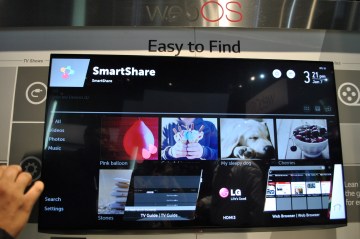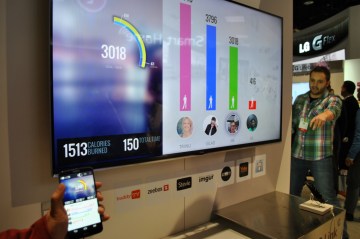TV makers have a habit of rebooting their smart TV platforms every few years, so it’s usually not a big deal when yet another platform debuts.
But LG wants to make a big deal out of WebOS. This is the rebirth of an operating system originally built for smartphones by Palm, left for dead by HP and ultimately revived for televisions by LG. It’s an interesting story, and LG isn’t afraid to advertise it by plastering the WebOS name all over its CES booth at the Las Vegas Convention Center. The company plans to put WebOS on 70% of its smart TVs this year.
From what I’ve seen so far, WebOS could be worth the fuss. The software is snappy and simple, and although WebOS wasn’t originally designed for TV, LG’s interpretation has a couple features to warm the hearts of Palm diehards.
Colin Zhao, director of product management at LG’s Silicon Valley Lab, told me that LG’s goal was to make sense of the explosion of TV channels and Internet options. “We realized that TV used to be simple,” he said.

LG’s version of WebOS uses the concept of a line, with the idea that it’s simpler to navigate than rows and columns of app icons. When you open the WebOS menu, a strip of italicized buttons spreads across the bottom of the screen, letting you choose between apps and live TV, while video continues to play above. In a nod to the vaunted multitasking of the old WebOS, pressing the leftmost button brings up a list of recent apps. LG’s WebOS even lets you dismiss recent apps by clicking an “X” above each one.
If you’re undecided on what to watch, a “today” button shows a list of the most popular movies and shows from LG’s store. Selecting any video brings up a list of video sources, including Netflix, Hulu, Vudu and CinemaNow. LG says it’s working with developers to include more options. WebOS also includes a web browser that seems like it has smartphone and tablet lineage, with support for multiple open windows. An LG representative said the browser supports Flash, Java and HTML5.

LG also showed off some clever connectivity with smartphones and tablets. Similar to Chromecast, WebOS will let users choose a Netflix or YouTube video from their phones or tablets, and then send the video to the television. LG is also working with other developers on more interesting screen-beaming applications. For instance, fitness company Neura created a big-screen version of its ACTV app, and WebOS users can launch it by pressing a button in ACTV’s smartphone app. Image sharing site Imgur is also adding a button to its app, letting users browse photos on a smartphone and view them on the television. Zhao said LG is using DIAL–the same prototocol that underpins Chromecast–along with DLNA and other protocols.
I asked Zhao why LG decided to buy WebOS from HP, rather than just build a new platform from scratch. Partly, it’s because of WebOS’s underlying technology and app development framework, which lets developers easily port their apps from other platforms. But Zhao also said LG wanted to acquire some of the WebOS team and begin making a name for itself in software design. The WebOS team represents LG’s first presence in Silicon Valley.
“LG recognizes that software is what now makes the next generation of consumer devices,” Zhao said.
That’s not something you hear often at CES, a show that has always been driven by hardware. But that’s exactly why CES’s relevance gets called into question every year. For LG, this isn’t just another smart TV platform, but a rebirth for the company, not unlike WebOS itself.

